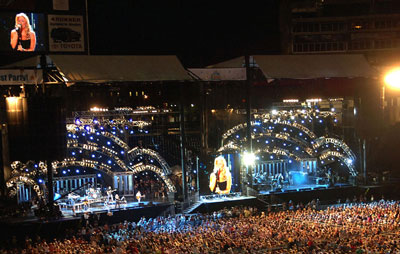By Amy Terrill, Vice President of Public Affairs, Music Canada, Toronto, Canada, and Alex Jacob, Spokesperson, IFPI, London, United Kingdom
Music is a powerful means of connecting people. It bridges linguistic and cultural divides, and is a vehicle for identity and expression like no other. Collectively, the music ecosystem generates rich social, cultural and economic benefits. A recent report, The Mastering of a Music City, by the global music industry body, IFPI, and its affiliate Music Canada, seeks to inspire cities around the world to cultivate a vibrant music economy within their community and become true Music Cities.

development and strengthens a city’s brand.
(photo: Nashville Convention & Visitors Corp.)
The report provides a comprehensive framework of strategies and best practices to help cities – local authorities, businesses, community groups and the creative sector – tap into the power of music. It is a roadmap for municipalities of all sizes to reach their Music City goals, offering useful insights about how to build a stronger and more lively music community.
Once exclusively associated with Nashville, Tennessee (USA), the term “Music City” now describes communities that have - or are encouraging - the development of a vibrant music economy. Music Cities can deliver significant economic and employment paybacks beyond their long-acknowledged cultural and social benefits.
The report draws on the experiences of 22 cities on all continents and 40 in-depth interviews as well as two focus groups to identify the opportunities and challenges associated with implementing a Music City strategy. Among the interviewees were music association leaders, music entrepreneurs including publishers, promoters and artists, municipal employees, and experts in tourism investment and economic development.
The study identifies five essential components of a successful Music City:
- the presence of artists and musicians;
- a thriving music scene;
- available spaces and places for music;
- a receptive and engaged audience;
- and record labels and other music-related businesses.
Music Cities also benefit from multi-level government support for music, including a broader city infrastructure conducive to the sector’s development and the availability of effective music education programs.
Music drives economic value
A vibrant music economy drives value for cities in several important ways. It fuels job creation, economic growth, tourism development and artistic growth, and strengthens a city’s brand. A strong music community also attracts highly skilled young workers in all sectors for whom quality of life is a priority. This in turn attracts business investment.
Many have quantified the value of music to local economies. The 2013 Nashville Music Industry report  found that the music industry helped create and sustain more than 56,000 local jobs and contributed USD5.5 billion to the local economy. In Melbourne, Australia, the 2012 census found that the live music sector alone generated over AUD1 billion in spending and supported the equivalent of 116,000 annual full-time jobs. Similarly, UK Music estimated that in 2013 music directly contributed GBP3.8 billion to the UK economy and directly employed 111,000 people.
found that the music industry helped create and sustain more than 56,000 local jobs and contributed USD5.5 billion to the local economy. In Melbourne, Australia, the 2012 census found that the live music sector alone generated over AUD1 billion in spending and supported the equivalent of 116,000 annual full-time jobs. Similarly, UK Music estimated that in 2013 music directly contributed GBP3.8 billion to the UK economy and directly employed 111,000 people.

Closing performance of AIM 21, Malaysia’s equivalent of the Grammy Awards. (photo: Recording Industry Association of Malaysia (RIM))
Key strategies to become a Music City
The report sets out seven key strategies to become successful Music Cities.
1. Creating music-friendly and musician-friendly policies
While it may be impossible to manufacture the secret something that causes artists and musicians to gather in a city, it is possible to create an environment that enables musicians to do what they do best: make music. Access to training and education programs, mentoring, music hubs or incubators as well as affordable housing can help attract and retain musicians, many of whom are on limited incomes.
Earning a living as an artist has never been easy. “It has never been easier to distribute a creative work. At the same time, it’s never been harder to get paid for it,” notes Robert Levine, past executive editor of Billboard. Professional development services for musicians not only help artists develop the skills they need to run their business and careers, they also make a municipality more music-friendly. In Bogotá (Colombia) the Chamber of Commerce is developing 30 different services to help artists and musicians monetize their work and build their businesses.
Land-use planning is perhaps the most complex area of municipal policy affecting the development of local music economies. Urban growth and competing demands for space mean many historic music venues, such as the 12 Bar in London (UK), RCA Studio A in Nashville, the Silver Dollar Room in Toronto (Canada) and the Palace Theatre in Melbourne, are under threat. Some have been saved, others have not.
Some cities have opted to designate individual buildings as heritage landmarks to protect them from developers. Others have gone further. For example, Montreal (Canada) has saved its Quartier des Spectacles from the bulldozers by designating it as an entertainment area. The one square kilometer area boasts 30 venues and hosts over 40 festivals, and is actively promoted as the nightlife destination.
Other cities, like Melbourne, are employing the “agent of change” principle to resolve problems arising when residential developments encroach on areas with established music venues and noise becomes a nuisance. If the “agent of change “is a new residential development near a pre-existing music venue, the developer is responsible for the costs of sound attenuation. But if the “agent of change” is the music venue then it is responsible for these costs. This principle works well where a cluster of established music venues is threatened by encroaching residential developments.
2. Establishing a music officer or office
Navigating music-related government policies and regulations can be a significant challenge. Some cities have established a music office or officer to act as a single point of contact between municipal authorities and the music community. For example, the Seattle Office of Film + Music in the USA serves as a one-stop shop for promoters and producers of live events, facilitating contacts with city departments (e.g. fire and police). These offices can also help mediate any potential areas of conflict.
3. Appointing a music advisory board
Music advisory boards are an invaluable link between the music community and City Hall. Generally composed of representatives from across the music community as well as tourism and economic development specialists, they offer advice and can play an important role in developing a consensus on legislative and regulatory issues. Music advisory boards make it possible to road test proposals with key stakeholders before approval by City Hall, thereby avoiding any unforeseen backlash. Some boards, such as the Memphis Music Commission (USA) which provides a legal clinic and pre-paid health care plans for musicians, also participate in the delivery of programs to the music community.
4. Engaging the support of the broader music community
Engaging those most affected by music strategies is critical to the success of any music city but can be challenging when it involves working with multiple small and medium-sized businesses, each playing a different role and often only working part-time in music.
The close cooperation of all stakeholders significantly improves the chances of developing effective regulatory and business environments that allow the music economy to thrive in the city. The Paris Music Council, for example, is seeking to find ways for the public and private sectors to work together to support artists and venues to ensure that Paris’ music offerings are rich, diverse and affordable.
5. Ensuring access to spaces and places
Music needs a home. In fact it needs many homes. From education to rehearsal to recording to performance, a successful Music City needs a variety of quality spaces and places. Supporting a community where artists can get started, develop their talent and shoot for the stars, requires a venue ladder – a full range of live venues, from tiny clubs to large stadiums, and everything in between.
This does not always involve new builds. Many communities have found innovative ways to renovate and repurpose abandoned movie theatres, churches and other buildings.
In some cities, the public and private sectors are working - sometimes together, sometimes separately - to build new spaces, such as music hubs or accelerators for artists and music businesses. For example, in Toronto, major record labels provide office space for a number of the independent labels with which they work. This is an ideal way to share know-how.
6. Supporting audience development
Any successful Music City needs a receptive and engaged audience. In addition to good transportation links and effective promotion of live music events, demographics also play an important role in audience development. Many Music Cities see large student populations as advantageous.
Tomorrow’s music fans are developing their entertainment tastes today. Events for all age groups help engage younger audiences, ensuring they develop a lifelong love of music.
7. Establishing a music tourism program
Music tourism generates billions of dollars for cities every year. Tourism assets include a city’s year-round live music scene, festivals and historical music landmarks. Major music festivals draw large numbers of tourists. For example, in 2014, 87 bands performed at Bogotá’s Rock al Parque (Rock in the Park), attracting some 400,000 people and making it one of the world’s largest music festivals.
Some cities have comprehensive music tourism strategies that involve music-based branding, promotional campaigns, social media strategies, music infrastructure investment, signage and programming.
Nashville, for example, puts music at the core of its brand. Its approach is paying off handsomely. In 2014, the city welcomed over 13 million visitors who contributed more than USD5 billion in revenues and supported 50,000 jobs. The city’s music note logo appears on buildings, souvenirs and promotional materials, and its tourist website, visitmusiccity.com, features a radio station with local artists and a wayfinding app for the public to connect with the live music scene.
Boosting a city’s music economy brings multiple dividends: it advances artistic and cultural growth, strengthens a community’s social fabric, creates jobs, and boosts economic activity and tourism spending. A vibrant music economy creates a “cool” factor and the quality of life that makes people want to live and work there, giving it an edge in attracting and retaining talent in all fields, businesses and investment. The guidelines proposed in The Mastering of a Music City encourage municipalities of all sizes around the world to tap into the power of their music to create more cohesive, vibrant and wealthy communities.



